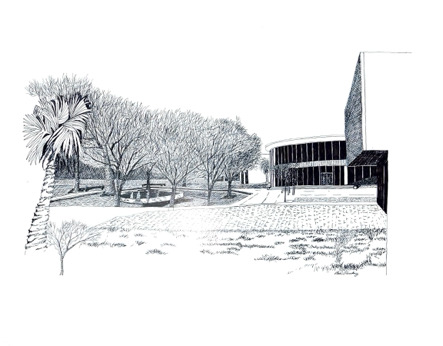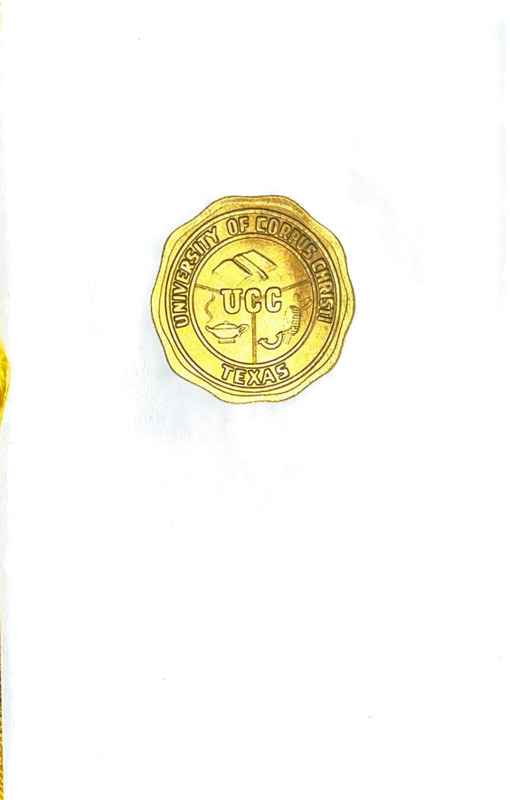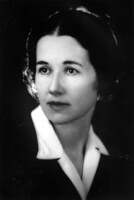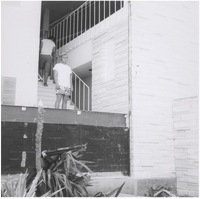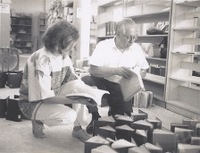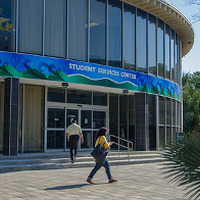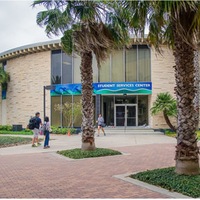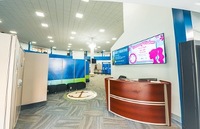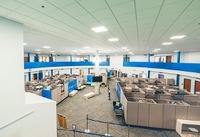The Round Building at Texas A&M University-Corpus Christi: History, Transformation, and Symbolism
by Julieta R. Chapman
Introduction
The narrative of the round building commences with the establishment of Texas A&M University-Corpus Christi in 1947, originally known as the University of Corpus Christi (UCC). Below is an image depicting UCC students as they install the new sign on the administration building, which states University of Corpus Christi. This illustrates that it encompasses more than just architectural history; it embodies the evolving identity, challenges, and ambitions of higher education in South Texas. Its phases of construction, destruction, and renewal tell a story of how institutions adjust in response to changing educational needs, political influences, financial constraints, and unforeseen crises. Collectively, the building and its historical context convey a fundamental concept: The Round building acts as both a physical and symbolic embodiment of the complex, resilient, and adaptive character of American higher Education.
Construction and Original Purpose
In the early years of the UCC, the library's resources were inadequate to satisfy the requirements of the student body and its academic programs; as a result, this problem was addressed, and proposals were developed that culminated in an agreement to construct a new library building on campus. (Johnson, 2021). The initiative to establish a new library in the 1960s highlights a common challenge faced by expanding institutions: the gap between academic ambitions and available resources. The insufficient library collections at UCC jeopardized its accreditation and constrained its academic credibility.
Architecture and Notable Features
The groundbreaking ceremony for the Round Building began in 1963, showcasing a modern, state-of-the-art facility. The choice to build a contemporary library spanning 24,000 square feet demonstrated an institutional commitment to enhancing academic standards, addressing enrollment demands, and establishing itself as a reputable higher education institution in Texas. This polygonal structure, characterized by its decagonal round shape, was designed to hold up to 80,000 volumes of individual books or bound collections of printed materials. The architectural design of the round building mirrors the trends of the mid-20th century, which prioritized natural light and expansive vistas. The extensive incorporation of glazing, along with the circular arrangement of the interiors, creates a unique educational atmosphere, rendering it a notable landmark on campus. (KRIS Coastal Bend History; TAMU-CC Library Exhibits). Its distinctive circular architecture, coupled with its historical importance and adaptability, positions it as a symbolic structure that represents both resilience and transformation within the campus community (Corpus Christi Caller, 1963; TAMU-CC Library Exhibits).
Opening Ceremony
The UCC Library was inaugurated on May 8, 1963, functioning as the primary library for the expanding institution. The construction costs for the circular structure in 1963 totaled $300,000. A building of this scale is projected to cost approximately $3,000,000.00 in today's market. Its design elements marked a significant architectural advancement for South Texas. (Corpus Christi Caller Times, 1963). The circular building stands as a representation of institutional ambition, aiming to fulfill and surpass academic standards. The structure encapsulated a commitment to progress and modernity, striving to provide the institution with an architectural identity that resonates with national trends in higher education design.
Gift
The construction of a circular building, designated as a new library at the University of Corpus Christi Campus, along with the enhancement of the library's collection, was made possible through a generous donation from Mary Elizabeth Holdsworth and her spouse, Howard Edward Butt. Both were affiliated with the H. E. Butt Foundation, a Christian-oriented organization based in Texas, dedicated to fostering wholeness in individuals and institutions to transform their communities. The contribution from the Butt family underscores the vital role of private philanthropy in influencing higher education, particularly for smaller or religiously affiliated institutions. Their engagement illustrates how personal, religious, and community connections have shaped campus development. The growth of institutions relies not solely on internal strategies but also on external partnerships and political support.
Hurricane Celia and Campus Impact
Hurricane Celia struck Corpus Christi on August 3, 1970, with wind speeds reaching 118 mph. This storm was one of the most severe to affect Corpus Christi in its documented history. It inflicted substantial property damage on the UCC campus, resulting in extensive destruction of campus facilities, particularly the Round Building. The library's collections suffered water damage, requiring significant recovery efforts. Dr. Carl Wrotenbery, the Dean of UCC, remarked that nearly every roof on campus was damaged. Photographs from that period document the efforts to salvage materials and highlight the resilience of the building (Corpus Christi Caller-Times, 1970; NOAA). The destruction wrought by Hurricane Celia demonstrates how environmental forces can reshape educational institutions. The storm challenged the campus’s physical and financial stability. However, the recovery efforts, with students and faculty salvaging books and administrators documenting the damage, underscore the community’s resilience. Disasters expose the vulnerability of educational institutions, yet they also reveal their ability to adapt and engage in collective problem-solving.
Repurposing as Student Services Center
After many years of serving as a library, and as the UCC transitioned into TAMUCC, the necessary changes rendered the once state-of-the-art library inadequate for academic requirements. However, it found a new role as the Student Services Center (SSC), commonly referred to as the "Round Building," which has become the administrative core of the campus. This facility now consolidates various administrative services for students, such as scholarships, admissions and enrollment assistance, financial aid, and support services for veterans. Currently, it continues to serve as a vital center for student engagement on campus (TAMU-CC Campus Map; Texas A&M University System, 2022). The round building exemplifies institutional reinvention and illustrates how educational environments are perpetually redefined to accommodate evolving student needs.
Services: Past and Present, Symbolism and Legacy, The Round Building as the Heart of the Island University Connecting Labaree’s A Perfect Mess
Initially, the structure included stacks of books, areas for reading, and study rooms (Corpus Christi Caller, 1963). At present, the Student Services Center (SSC) offers offices specifically for student services, advising, enrollment assistance, and various other administrative roles designed to support students (TAMU-CC Campus Map; SSC photos). David F. Labaree posits that the success of American higher education lies in its inherent disorder. He characterizes higher education as an ecosystem influenced by conflict, contradiction, competition, and improvisation. The history of the round building illustrates Labaree’s thesis in four distinct ways:
1 Resource scarcity and entrepreneurial solutions: UCC faced a lack of resources and infrastructure typically associated with universities, yet it found ways to adapt. The philanthropic support from the Butt Foundation exemplifies the entrepreneurial and decentralized funding methods that Labaree identifies as hallmarks of American higher education.
2 Institutional mission drift and adaptation: Labaree observes that universities change in response to external pressures rather than through systematic planning. The Round Building transitioned from a library to a comprehensive administrative center. This transformation signifies institutional strategies for survival in the face of evolving student needs, increased enrollment, and changing academic standards.
3 Crisis as a catalyst for reform: Hurricane Celia serves as an example of Labaree’s assertion that disruption frequently accelerates change instead of hindering it. The period of reconstruction played a significant role in the institution’s long-term evolution into what is now TAMU-CC.
4 Symbolic architecture and institutional identity: Labaree highlights that universities prioritize imagery and symbolism as part of their competitive strategy. The Round Building, with its unique, modern, and visually striking design, became integral to the narrative of “The Island University,” merging local identity with institutional aspirations. (Labaree, 2017).
Connecting Weaver-Hightower’s Policy Ecology
Weaver-Hightower suggests examining educational policy through four distinct categories:
1. Actors - University leadership (administrators, deans), students advocating for improved resources, donors (Mary Elizabeth and Howard E. Butt), local community members, state and local officials, and the TAMU System following its acquisition. These actors worked together, sometimes inadvertently, to influence the purpose and evolution of the round building.
2. Relationships - The collaboration between UCC and the Butt Foundation, student involvement with the library and subsequent services, coordination among recovery teams post-Hurricane Celia, and administrative connections with the TAMU System. These relational networks illustrate how informal partnerships affect campus development.
3. Environments & structures - Coastal geographic vulnerabilities, resource constraints typical of small private colleges, architectural conventions from the 1960s, physical damage caused by Hurricane Celia, and evolving technological and academic requirements. Both physical and environmental structures significantly influenced institutional decisions.
4. Processes - Planning, funding, and constructing buildings, disaster recovery and reconstruction, the transformation of institutions over time (from UCC to TAMU-CC), and reimagining spaces to accommodate changing student needs. These processes reveal that campus development is iterative, contingent, and nonlinear—reflecting Labaree’s concept of a “perfect mess.”
This framework aids in contextualizing the Round Building within a larger institutional ecology.
Connections Between Historical Documents and Current Events
The archival photographs, maps, dedication programs, and construction records highlight several current issues in higher education:
1. Climate Resilience and Disaster Planning
The devastation wrought by Hurricane Celia mirrors present-day concerns regarding climate change and the vulnerability of coastal campuses. Universities—particularly those located on islands or near coastlines—are reassessing their infrastructure resilience, emergency preparedness, and architectural design.
2. Shifts Toward Student-Centered Services
The conversion of the Round Building into a Student Services Center exemplifies a national trend: institutions are restructuring to enhance retention, advising, financial aid navigation, and comprehensive support services. As enrollment challenges escalate across the United States, these services have become vital for student success.
3. The Increasing Role of Donors and Private Funding
Like how the Butt family’s donation influenced UCC, contemporary institutions are becoming more reliant on philanthropic contributions. Donor-funded construction projects are increasingly shaping campus architecture and the allocation of resources.
4. Preserving Institutional Memory
The archival materials indicate a growing awareness of the significance of institutional history as campuses strive to maintain their identity, garner alumni support, and assert their heritage amidst rapid changes.
Synthesis: What the Round Building Represents
Integrating historical, architectural, institutional, and theoretical viewpoints:
The Round Building exemplifies the extensive history of American higher education, illustrating how institutions adapt, face challenges, reconstruct, and redefine their identities in response to evolving pressures and unforeseen obstacles.
It represents:
• an embodiment of institutional aspiration
• a resilient survivor of an environmental catastrophe
• a versatile, repurposed asset for the campus
• a representation of identity for TAMU-CC
References
Corpus Christi Caller Times. (1963). UCC Library Dedication.
Corpus Christi Caller-Times. (1970). Photographs showing library materials recovery after Hurricane Celia.
Johnson, A., (2021). The island university A history of Texas A&M University-Corpus Christi. Andrew Johnson Publisher.
KRIS Coastal Bend History (n.d.). Corpus Christi's first round building.
Labaree, D. F. (2017). A perfect mess: The unlikely ascendancy of American higher education. University of Chicago Press.
NOAA / Weather Service. (1970) Hurricane Celia Summary.
TAMU-CC Campus Map (n.d.). Student Services Center Location and Services.
TAMU-CC Library Exhibits. (1963). University of Corpus Christi Library Dedication materials.
Texas A&M University System. (2022). Consent Agenda: Student Services Center renovation project.
Weaver-Hightower, M. B. (2008). An ecology metaphor for educational policy analysis: A call to complexity. Educational Researcher, 37(3).



